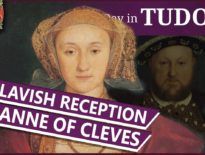On this day in Tudor history, 12th December 1595, Protestant Welsh soldier and author, Sir Roger Williams, died from a fever with his patron, Robert Devereux, Earl of Essex, at his side. He was buried at St Paul's Cathedral.
Williams served as a soldier in the Low Countries and France and was second in command of the cavalry under Essex at Tilbury Fort in 1588. He also wrote the 1590 “A Briefe Discourse of Warre”.
At one point he incurred Queen Elizabeth I's wrath and had to go into hiding for a time.
Find out all about Sir Roger Williams' life, career and works in today's talk.
“A brief discourse of war” can be read at https://quod.lib.umich.edu/e/eebo/A15466.0001.001?view=toc
Also on this day in Tudor history, 12th December 1546, Henry Howard, Earl of Surrey, son of Thomas Howard, 3rd Duke of Norfolk, was led through the streets of London from Ely Place, where he had been held since his arrest on 2nd December, to the Tower of London.
It was meant to be a humiliating walk for the earl, but it seems that the citizens of London were actually sympathetic to his plight, and didn't boo him. Find out what happened on this day, and also what happened to his father, who had also been arrested, in last year’s video:
Also on this day in history:
- 1574 – Birth of Anne of Denmark, Queen of England, Scotland, and Ireland as consort of James I, at Skanderborg Castle, Jutland, Denmark. Anne was the second daughter of Frederick II, King of Denmark and Norway, and his wife, Sophia. She married James I, when he was James VI of Scotland, by proxy on 20th August 1589, and in a proper church ceremony on 23rd November 1589. The couple's children included the future Charles I and Elizabeth Stuart, Queen of Bohemia. Anne died on 2nd March 1619 of consumption and dropsy, and was buried in Henry VII's Chapel, Westminster Abbey.
Transcript:
On this day in Tudor history, 12th December 1595, Protestant Welsh soldier and author, Sir Roger Williams, died from a fever with his patron, Robert Devereux, Earl of Essex, at his side. He was buried at St Paul's Cathedral.
Williams served as a soldier in the Low Countries and France, and was second in command of the cavalry under Essex at Tilbury Fort in 1588. He also wrote the 1590 “A Briefe Discourse of Warre”.
Let me tell you a bit more about him…
• Williams was born in around 1539/40 and was the son of Sir Thomas Williams of Penrhos, Monmouthshire in Wales, and his wife, Eleanor Vaughan.
• It is thought that Williams was educated at Brasenose College, Oxford, before entering the service of William Herbert, 1st Earl of Pembroke, as a page.
• He may have accompanied Pembroke to the Low Countries in 1557 in the campaign against the French, on the side of Philip of Spain, husband of Mary I, but it’s not certain. It is thought that he served on the Huguenot side in the 1560s during the French Wars of Religion.
• In 1572, in Elizabeth I’s reign, he was one of those who volunteered for service under Thomas Morgan in a revolt with the Dutch against Philip of Spain. In 1573, when Morgan returned home, Williams, who had heard a rumour that the Huguenots were raising an army in Rhineland, travelled there, but headed home when the news turned out to be wrong. He was arrested by the Spanish while on his journey, luckily being captured by a commander who had served with his patron, Pembroke, in Mary’s reign. Williams, who was obviously a keen soldier, accepted the commander’s offer to enlist in his regiment, serving in it until 1577.
• In the summer of 1577, following his return to England, Williams was employed as an intelligence gatherer by Sir Francis Walsingham. Perhaps he had used his time serving under Spain to gather intelligence for Elizabeth I’s government.
• In 1578, Williams joined a regiment led by John Norris in the Netherlands. Elizabeth’s ambassador, William Davison, had to intercede as the Dutch were suspicious of Williams at first, due to his recent history of service under Spain. He soon proved himself by fighting a Spaniard single-handedly.
• Williams served Norris loyally as a lieutenant for a few years, although the two men were prone to arguments. Williams’ brother was sadly killed by the Spanish in 1582.
• Williams stayed on serving on the Dutch side after Norris left, and became close to William of Orange. He was with the prince when Catholic Balthasar Gerard assassinated him in July 1584 and gave chase, helping to capture Gerard.
• In 1585 he served with Norris once more as lieutenant colonel and continuing his service when Robert Dudley, Earl of Leicester, took command. He got to know the earl’s stepson, Robert Devereux, 2nd Earl of Essex, at this time.
• Williams was knighted by Leicester in October 1586 as a reward for his service.
• In 1587, Williams was made governor of Sluys and was there when the Duke of Parma laid siege to the town. Williams and his force resisted for nearly two months before being forced to surrender in August 1587.
• In late 1587, Williams fell out with the Earl of Leicester, but in 1588, at the time of the Spanish Armada’s predicted invasion, he served as second in command of the cavalry to the Earl of Essex at Tilbury Fort.
• In 1589, he commander a regiment during Norris’s and Sir Francis Drake’s expedition to Portugal, incurring the wrath of Queen Elizabeth I, when he allowed the Earl of Essex to stow away on his ship after she’d refused to let Essex go. So angry was Elizabeth that Williams went into hiding for a time on his return to England.
• In 1589, Williams also served in France under Henry IV, before joining the English army commanded by Peregrine Bertie. His service there helped him win back the queen’s favour.
• In 1590, his work “A Brief Discourse of War, with his opinions concerning some part of Martial Discipline” was published, and this was followed, the next year, by “Newes from Sir Roger Williams”.
• In early 1591, even though he and his friend Essex had criticised Norris, Williams served under Norris as a colonel in Brittany. That summer, he served as Marshal of the Field under Essex, and, after Essex was recalled in 1592, he became commander of the army.
• In 1594, Elizabeth I granted him a life pension of £300, and in that year and 1595, he served her as special ambassador to the French king.
• Williams died on this day in history, 12th December 1595, after just 4 days of illness. His patron and friend, the Earl of Essex, was by his side.
• In his will, he instructed for his goods to be given to the Earl of Essex. He had never married.
• He was buried in St Paul’s Cathedral on 23rd December 1595 in a funeral paid for by Essex and attended by the earl and Williams’ military colleagues.
• In 1618, “Actions of the Low Countries”, Williams’ account of his time in the Netherlands, was published
• There is a story, probably apocryphal, regarding Williams’ relationship with Queen Elizabeth I, which wasn’t plain sailing. Apparently, tired of his petitioning, the queen said, “'Faugh/Fah, Williams, I prithee begone: thy boots stink,”, to which Williams replied, “Tut, madam, 'tis my suit that stinks”.
• Williams has been linked with William Shakespeare’s Welsh soldier Fluellan in Henry V, but although Fluellan’s fiery but witty personality matches that of Williams, Fluellan was a conservative soldier, while Williams was a moderniser.



Leave a Reply